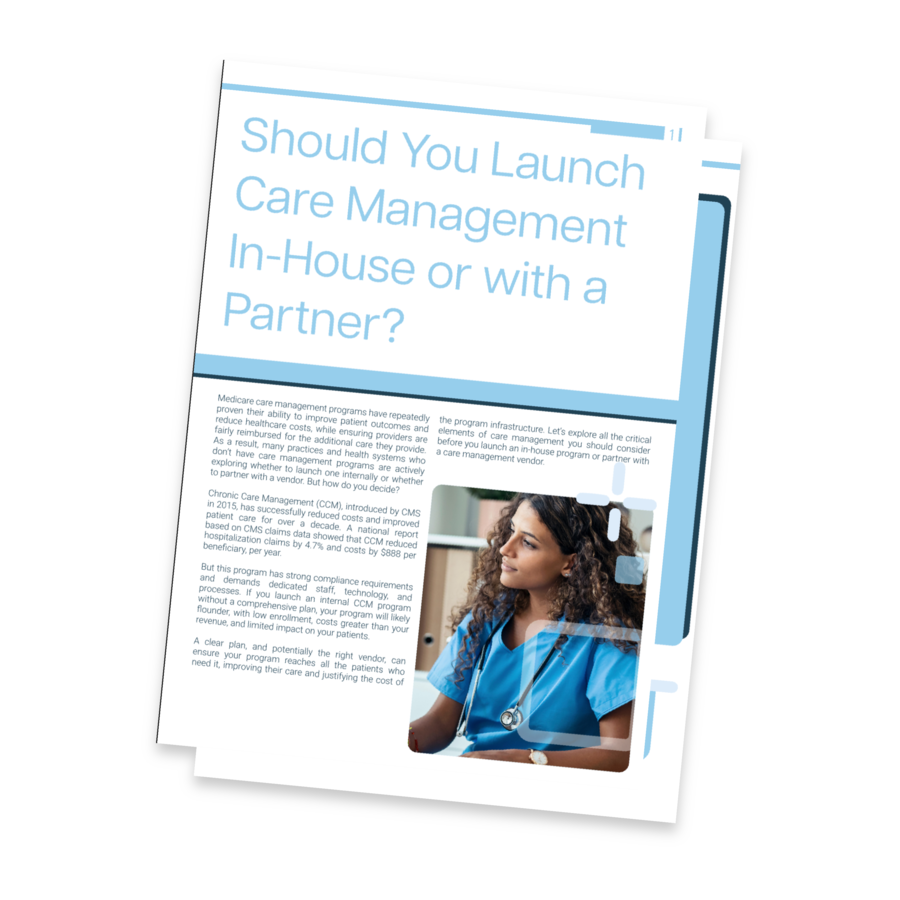
Talk with a ChartSpan Representative Today!
Our team is ready to help you improve patient care and outcomes.
Blog
The Provider’s Guide to Patient Engagement
Delivering excellent care goes beyond clinical expertise—it requires a partnership. Accurate diagnoses and evidence-based treatments are essential, but they’re only part of the equation. Lasting health improvements depend on how well patients understand, participate in, and follow through with their care plans. When patients are actively engaged in their care, they’re more likely to adhere to treatment, manage chronic conditions effectively, and report higher satisfaction—all while contributing to lower overall healthcare costs.
Yet, for many providers, encouraging that level of involvement—especially among patients managing multiple chronic conditions—is easier said than done. Barriers like limited health literacy, social determinants of health, and fragmented care systems can all hinder engagement.
That’s where a proactive, structured approach makes a difference. By embedding engagement into your care model—with the right tools, touchpoints, and support—you can foster stronger relationships with your patients and help them take ownership of their health journeys.
This guide explores why patient engagement matters, how to overcome common challenges, and how programs like Chronic Care Management (CCM) and Advanced Primary Care Management (APCM) can help you make engagement more consistent and sustainable across your patient population.
The importance of patient engagement in improving outcomes
Implementing patient engagement strategies takes deliberate effort, but the return is well worth it. Engaged patients are more likely to follow care plans, manage chronic conditions effectively, and maintain consistent communication with providers. Here’s what you can expect when engagement becomes a core part of your care model.
Better health outcomes
Engaged patients are happier and healthier patients. They are more likely to take their medications, show up for appointments, and take preventive steps to improve their health, like maintaining a healthy exercise routine, receiving immunizations, and scheduling routine screenings. Patients who are involved in their care are also less likely to be readmitted to the hospital after discharge. Increased patient engagement also leads to reduced rates of anxiety.
Greater treatment adherence
While genetic factors do play a role, so much of chronic disease risk is controllable. However, preventing chronic illness requires patient commitment and motivation. Engaged patients are more likely to follow provider recommendations, yielding better treatment results and potentially preventing more acute interventions.
Improved patient confidence
When patients are engaged in the delivery of care, they gain a sense of control over their health. The ability to confidently navigate treatment and self-manage their conditions is invaluable. These independent, empowered patients are ultimately more satisfied with their care experiences and enjoy a higher quality of life than those who require more support.
Reduced healthcare costs
Involved patients are a critical piece of the preventive model of care. By participating in their care, patients can often avoid acute interventions, which are more costly for both patients and providers. Patient engagement also supports greater efficiency and increases return on investment for healthcare teams. In contrast, patients with the lowest levels of engagement are also those with the highest healthcare costs.
Common barriers that undermine patient engagement
Patient engagement isn’t just about communication; it’s about addressing the structural, behavioral, and emotional barriers that stand in the way of active participation. Common obstacles include:
- Low health literacy: Patients may not fully understand their diagnoses, treatment options, or how to manage their conditions between visits. This lack of understanding can lead to confusion, inaction, or poor decision-making.
- Access challenges: Transportation difficulties, financial constraints, lack of childcare, and limited digital access can prevent patients from scheduling or attending appointments and following through with care plans.
- Mental health and motivation: Depression, anxiety, and chronic stress are common among patients with long-term conditions, and they often lead to disengagement. When patients are overwhelmed, even small healthcare tasks can feel unmanageable.
- Language and cultural barriers: Misalignment in language, cultural norms, or communication style can make patients feel unheard or unsupported, reducing trust and participation.
- Fragmented care delivery: When patients receive care from multiple providers without coordination, they may not know where to turn for answers, or may receive conflicting advice that undermines confidence.
Overcoming these barriers requires an intentional, structured approach—one that integrates clinical guidance with education, emotional support, and logistical help.
Patient engagement strategies that work
Experiencing the benefits of patient engagement requires providers to adopt a collaborative care approach—one in which patients are partners in achieving optimal health. Value-based care programs like Chronic Care Management (CCM) and Advanced Primary Care Management (APCM) programs extend care beyond the exam room, offering consistent, personalized support between visits.
These programs create structured pathways to engage patients in managing their health more proactively, especially those patients with chronic conditions or elevated risk factors. By offering reimbursement for proactive, relationship-centered care, CCM and APCM provide a means of supporting patient engagement more consistently and effectively.
These programs work by applying practical, patient-centered strategies that drive results:
- 24/7 access to care: Facilitate continuous, two-way communication by ensuring patients have around-the-clock access to clinical guidance. Care manager advice lines and care coordination services help patients determine the appropriate level of care—whether it's managing symptoms at home or seeking emergency treatment—reducing unnecessary ER visits and improving confidence in self-management.
- Personalized care plans: Tailor care plans to align with patient needs and goals. For chronic conditions, this means developing proactive care plans that align with patients’ entire picture of health, including lifestyle preferences. Effective care plans incorporate specific, measurable benchmarks that give patients clear goalposts for success.
- Social Determinants of Health (SDOH) support: Give patients the tools to overcome barriers to achieving their health potential. This may include helping them access healthy food, transportation assistance for appointments, or even safe housing resources. Alternatively, SDOH support could include setting up medication refills with a local pharmacy. In any case, engagement means supporting the whole patient, even beyond the traditional scope of healthcare services.
- Community engagement: Connect patients to other sources of support. Encouraging them to participate in exercise groups, for example, can offer the accountability they need to help them stick to their care plans. Alternatively, referring patients to mental health resources can help them reduce stress and achieve better outcomes.
- Patient education: Support patients via resources that complement in-person provider interactions and build knowledge. Whether it’s more information about a specific condition, healthy recipe ideas that align with their dietary needs, or personalized exercise recommendations, ongoing patient education is one of the cornerstones of engagement.
- Consistent outreach: Maintain a cadence of communicating with your patients. While choosing to engage is ultimately the patient’s decision, it’s your job to let them know you’re there for them. Give them multiple avenues to reach you, so that they have a choice in how to connect.
- Digital communication: Leverage healthcare technology to connect with your patients. Tools like two-way texting, routine telephone check-ins, and digital patient surveys help to keep patients feeling engaged and informed between appointments.
How ChartSpan enhances engagement for patients with chronic conditions
Supporting engagement, especially for patients with multiple chronic conditions, requires sustained effort, consistent communication, and a proactive care approach. ChartSpan works alongside providers like you, giving patients the tools and resources to enact patient engagement strategies without overburdening their existing teams. We do that through our full-service CCM and APCM programs.
Chronic Care Management program
CCM is a Medicare-supported program designed to achieve better health outcomes and quality of life for patients with two or more qualifying chronic conditions. CCM is a preventive care model that aims to reduce costly acute care incidents. Patient self-management is at the heart of the program, and the Medicare requirements are structured to promote engagement.
Patients who participate in ChartSpan’s CCM program receive:
- Monthly phone calls from a dedicated care team member to review progress, set health goals, and answer questions.
- 24/7 access to a staffed care line, so patients can receive guidance anytime they need it, helping them avoid unnecessary visits to the emergency department.
- Personalized care plans that align with their lifestyle preferences and chronic conditions, setting them up for long-term health.
- Support with medication refills, scheduling, and transportation to eliminate barriers to care.
- Connection to SDOH resources, like housing support, food assistance, and access to care.
- Educational resources tailored to each patient’s needs, such as heart-healthy recipes for patients with cardiovascular disease or low-impact exercise ideas for patients suffering from chronic pain.
- Two-way texting and digital touchpoints to give patients information through channels they’re comfortable with and keep them in the loop about upcoming appointments.
Whether we’re sharing ideas for stress reduction or reminding a patient about a prescription refill, we always use HIPAA-compliant tools. Instead of replacing your existing EHR system, we work with it to support seamless care coordination. In the event a patient needs more support, we escalate high-priority situations directly to your team so that your patients receive timely, appropriate interventions. As part of our Chronic Care Management program, we also document our patient engagement efforts, making it easier to comply with Medicare regulations.
Advanced Primary Care Management program
APCM is a preventive care framework funded by Medicare that supports population health, especially for patients who don’t qualify for CCM. While CCM applies strictly to patients with two or more chronic conditions, APCM stratifies patients into three levels based on their risk. This broader categorization makes it possible to support patient-centered care across multiple providers for all Medicare patients.
Our advanced care program reduces the logistical burden of ongoing patient engagement by supporting patients in the following key ways.
- Digital or phone-based outreach to patients at a custom cadence suited to their needs and for as long or as little time as needed—there’s no minimum time requirement.
- SDOH support, including housing, mental health, food, and transportation support, especially for those APCM patients who are also Qualified Medicare Beneficiaries (QMB).
- Connection to additional care services, including in-home or community-based services, based on provider recommendations.
- Targeted education and support, tailored to patients’ unique preventive care goals, which may include encouraging Annual Wellness Visits, screenings, or immunizations.
- Connections to local resources, such as wellness programs or support groups.
- HIPAA-compliant two-way texting and surveys to stay connected with patients and keep care aligned with their preferences.
Both APCM and CCM support patient engagement in similar, and often overlapping ways. Still, you don’t necessarily have to choose one program or the other. Some patients can be billed for APCM, while others may instead enroll in CCM. Working with a partner like ChartSpan can help you clarify the nuances in each approach and make implementing a new program more manageable.
Comprehensive support without the in-house burden
It’s one thing to recognize the benefits of patient engagement and another to implement the systems and processes needed to support it. By partnering with ChartSpan, you can engage your patients—and help them experience better health—without straining your existing team and resources. Our CCM and APCM programs offer a scalable way to extend a patient-centered care model beyond the walls of your practice.
Contact us to talk to an expert and discover how our fully-managed care programs can help you improve patient experiences and outcomes.
→ Learn more about our Chronic Care Management program
→ Learn more about our Advanced Primary Care Management program
You might also like:
Subscribe for More Insights
Get valuable resources delivered straight to your inbox.
"*" indicates required fields






